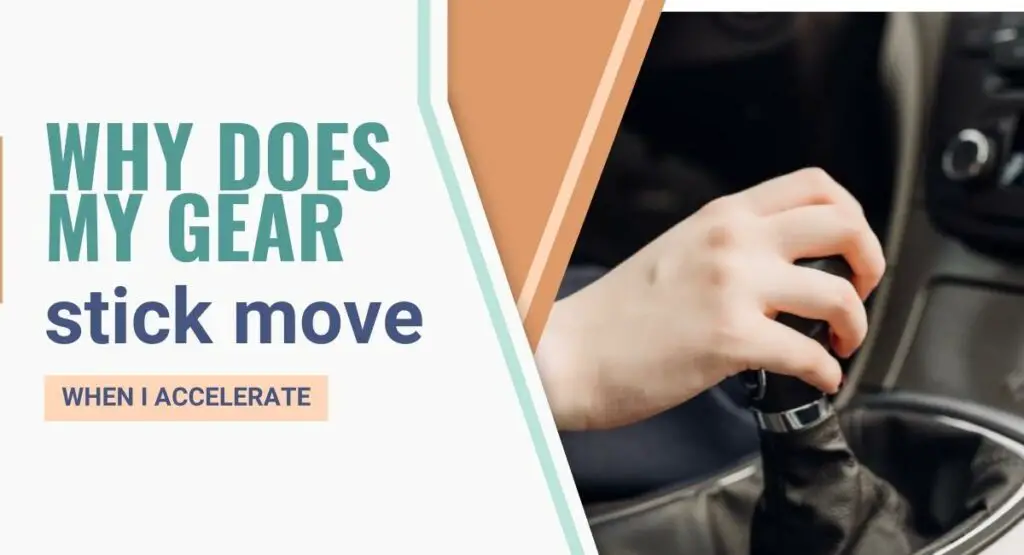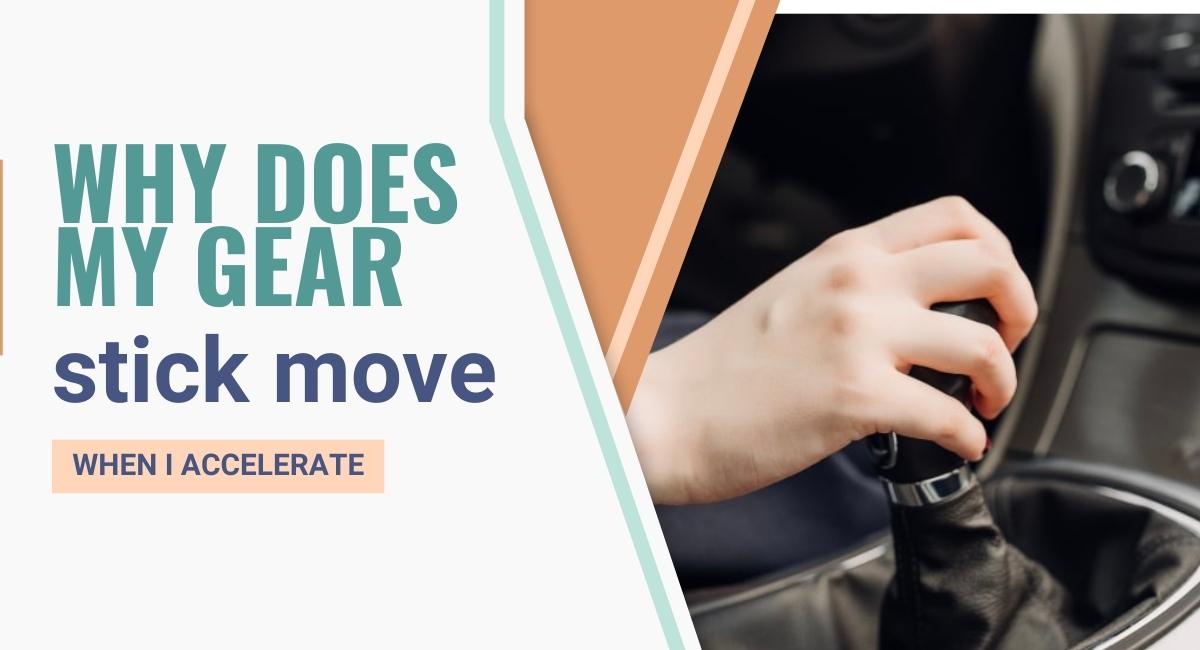The art of driving a manual transmission vehicle is a dance between the driver and the machine, where every gear shift and acceleration creates a symphony of power and control.
But amidst this intricate performance, there’s a mystery that often leaves drivers perplexed: why does the gear stick move when we accelerate? It’s a quirk that can catch us off guard, making us question the inner workings of our beloved manual transmissions.
If you’ve noticed your gear stick move when accelerating, you may have wondered what causes this phenomenon. This article highlights the inner workings of manual transmissions, explores the relationship between acceleration and gear shifting, and uncovers the possible reasons behind your gear stick’s erratic behavior.
The function of the Gear Stick
Before we dive into the specifics, let’s establish the role of the gear stick. In a manual transmission vehicle, the gear stick is the interface between the driver and the transmission system. It allows the driver to select and engage different gears, thereby controlling the power and torque distribution from the engine to the wheels.
The gear stick’s movement corresponds to the gear selection made by the driver, enabling smooth transitions between gears.
Transmission Components
To understand why the gear stick shakes during acceleration, we need to familiarize ourselves with the critical components of the transmission system. The transmission system consists of several essential parts, including the clutch, gearbox, synchronizers, and drive shafts.
The clutch between the engine and the gearbox connects and disconnects the engine’s power to the transmission. The gearbox houses a set of gears that determine the vehicle’s speed and power output.
And synchronizers facilitate smooth gear engagements by equalizing rotational speeds between different components. Finally, the drive shafts transmit power from the gearbox to the wheels.
Acceleration and Gear Shifting
Acceleration in a manual transmission vehicle is closely tied to gear shifting. When you accelerate, the engine generates more power, which needs to get to the wheels. The clutch plays a vital role in this process by engaging and disengaging the engine’s power flow to the gearbox.
As you press the accelerator, the clutch gradually engages, allowing the transmission of power to the wheels. Gear shifting becomes necessary to optimize performance and fuel efficiency. Upshifting involves moving to higher gears to accommodate increasing speeds, while downshifting allows for more torque and power at lower speeds.

Gear Stick Moves When in Gear
If you notice that you can move the gear stick approximately 2-3 cm while it is in gear, it could be due to a worn gear stick joint housing, worn bushing, or a snapped rubber spacer/washer at the gearbox. It is possible to resolve a gear shifting when in gear by creating a new bushing and a solid ball joint housing.
Causes of Gear Stick Movement during Acceleration
Now, let’s address the primary question: why does the gear stick move during acceleration? In most cases, some gear stick movement is normal during gear shifting, especially when you transition between gears quickly. However, if you notice excessive or unexpected gear stick movement, several issues might be at play:
- Worn or loose gear linkage: Over time, the gear linkage, which connects the gear stick to the gearbox, can become worn or loose, resulting in increased movement. Plus, it is the reason the gear stick moves when in gear.
- Damaged synchronizers: Faulty or damaged synchronizers can cause gear engagement issues, leading to irregular gear stick movement during acceleration.
- Malfunctioning clutch system: A worn-out clutch, improper clutch adjustment, or hydraulic issues can affect the smooth engagement of gears, resulting in gear stick movement.
- Faulty gearbox mounts: Damaged or worn gearbox mounts can allow excessive movement of the gearbox, causing the gear stick to vibrate or shift unexpectedly.
- Other mechanical issues: Various mechanical problems, such as worn bushings, damaged selector forks, or internal gearbox damage, can contribute to abnormal gear stick movement.
Effects of Gear Stick Movement during Acceleration
The erratic movement of the gear stick during acceleration can have several effects on your driving experience and overall vehicle control.
- It can create discomfort and distraction, affecting your ability to concentrate on the road.
- Excessive gear stick movement might lead to difficulty in accurately selecting gears, resulting in imprecise shifts and possible gear grinding.
- Moreover, the unexpected jolts or vibrations transmitted through the gear stick can negatively impact the overall driving experience, reducing comfort and enjoyment.
- Furthermore, ignoring or neglecting the issue may lead to more severe damage to the transmission system, resulting in costly repairs.
Diagnosing and Resolving the Issue
While proper maintenance and regular check-ups are essential to ensure the longevity and performance of your transmission system, adhering to recommended service intervals and addressing any emerging issues can prevent more severe damage and costly repairs in the future. Besides, addressing the problem is essential if you’re experiencing excessive gear stick movement during acceleration. Here’s a step-by-step troubleshooting process:
Important Read: Understanding the Bell Ringing Sound in Your Car
Inspecting gear linkage
Start by examining the gear linkage, which connects the gear stick to the gearbox. Look for any signs of wear, looseness, or damage. Worn bushings or loose connections can contribute to excessive gear stick movement. If found, tighten or replace the worn parts.
Checking the clutch system
The clutch plays a critical role in the smooth engagement of gears. Check for signs of wear or damage on the clutch plate. Ensures the hydraulic system is functioning properly and the clutch is adjusted correctly. If necessary, consult a professional to repair or replace the clutch components.
Assessing synchronizers and gearbox mounts
Synchronizers ensure smooth gear engagements by equalizing rotational speeds. Damaged synchronizers may cause irregular shifts and gear stick movement. Worn or damaged gearbox mounts can allow excessive movement, affecting the gear stick’s stability. Consider having a professional inspect these components and replace them if necessary.
Seeking professional assistance
If the issue persists or you’re unsure about the diagnosis, it’s advisable to seek the expertise of a qualified mechanic specializing in manual transmissions. They have the knowledge and experience to evaluate your transmission system comprehensively. They can accurately identify any underlying issues and provide appropriate solutions to resolve the gear stick movement problem.
Regular Maintenance
As mentioned, regular maintenance practices can help prevent gear stick movement issues. Routine inspections, fluid changes, and lubrication of transmission components can ensure optimal performance and reduce the likelihood of unexpected gear stick movement. Following the manufacturer’s recommended maintenance schedule and guidelines is crucial in maintaining a healthy transmission system.
Conclusion
The movement of the gear stick during acceleration in a manual transmission vehicle can be a perplexing issue. By understanding the intricate relationship between acceleration and gear shifting, as well as the various components of the transmission system, you can shed light on the mystery. Whether it’s worn gear linkage, damaged synchronizers, or a malfunctioning clutch system, promptly diagnosing and resolving the issue is crucial for a safe and enjoyable driving experience. Remember, a well-maintained transmission system ensures smooth gear engagements and reliable performance, allowing you to fully appreciate the art of driving a manual vehicle.

